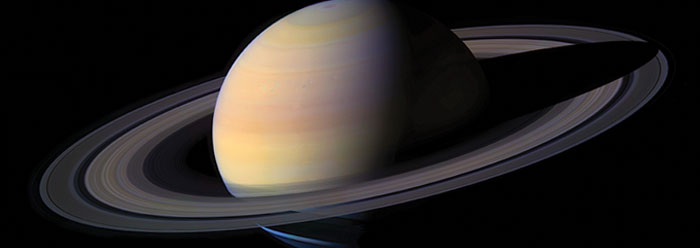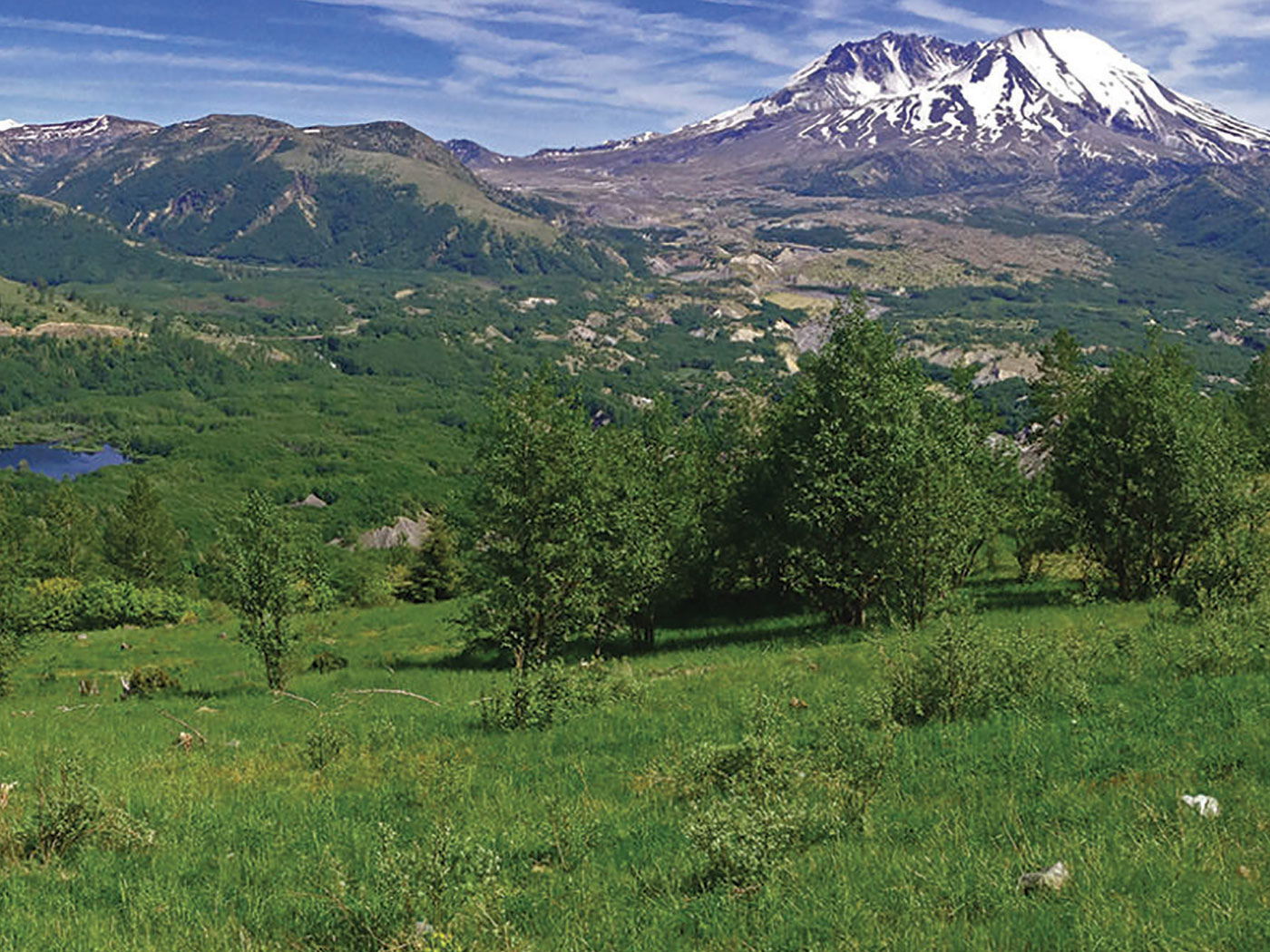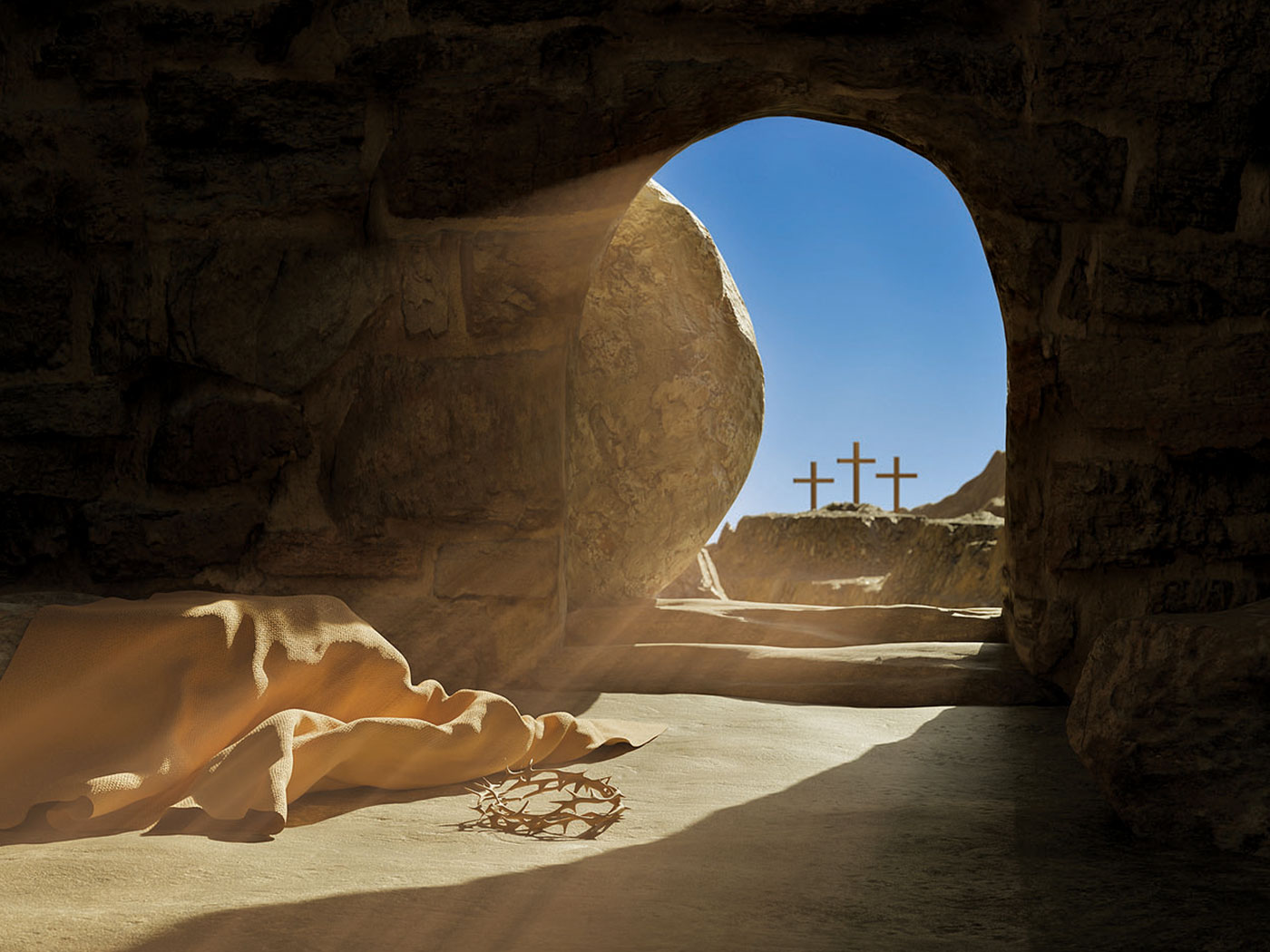When people peer into a telescope and see Saturn for the first time, the typical response is “Wow!” All the other planets appear as simple disks with a few surface features, but Saturn’s rich system of rings makes it look more like a piece of celestial jewelry. Composed of trillions of tiny moonlets—particles of water ice—these rings orbit Saturn, giving it a stunning, three-dimensional appearance quite different from any other planet.
Basic Properties
Saturn is a slightly smaller version of Jupiter in most respects. It is made of hydrogen and helium gas and trace amounts of molecules such as the methane and ammonia that give rise to its yellow color. As with Jupiter, colorful clouds are stretched into belts (dark-colored) and zones (lightcolored). However, Saturn’s belts and zones are more subtle than Jupiter’s.
Nine times the size of Earth in diameter, Saturn has the lowest density of any planet and, amazingly, would actually float in water. At a distance of 890 million miles from the sun, Saturn takes 29.5 years to complete just one orbit.
Powerful storms large enough to be seen from Earth occasionally develop in Saturn’s atmosphere and appear as bright regions within the belts and zones. Although Saturn has no permanent storms like Jupiter’s Great Red Spot, its intermittent storms can last for many months. A Great White Spot manifests roughly every 30 years during the planet’s northern hemisphere summer and can periodically occur in off-years as well, as it did in 2010.
Lord of the Rings
Even though Jupiter, Uranus, and Neptune all have their own system of rings, Saturn’s are by far the most impressive. The main rings span 170,000 miles across but are less than one mile thick. For comparison, this is over one thousand times thinner than the relative thickness of a DVD. The rings orbit in the plane of Saturn’s equator. Fortunately, the planet’s rotation axis is tilted 26.7 degrees in relation to the planetary orbital plane, which affords us a lovely view of the rings. Without this tilt, the rings would always appear edge-on, making them virtually invisible.
As it orbits the sun, Saturn’s tilt does not change—it’s our perspective of the planet that shifts as we see it from various angles. From Earth, it appears as though Saturn’s tilt gradually moves from 26.7 degrees to negative 26.7 degrees and back every 29.5 years as Saturn completes its orbit.
For this reason, every 15 years or so Saturn’s equator appears edge-on from our viewpoint. This occurs around the time that Saturn experiences its spring or fall equinox—the period when Saturn’s equatorial plane intersects the sun. Since Saturn’s rings orbit its equator, they, too, appear nearly edge-on for many months around the time of the Saturnian equinoxes, resembling a pin stuck through the middle of a grape. For the weeks surrounding the moment of equinox, Saturn’s rings are so close to edgeon that they are hidden, drastically changing the planet’s appearance. The last edge-on view occurred in September 2009, and the next one will be in March 2025. Conversely, when the sun is farthest from Saturn’s equatorial plane during the planet’s summer and winter solstices, we observe Saturn with its northern or southern hemisphere respectively tipped maximally toward us. At these times, we can get our most spectacular view of the rings.
Saturn has several different systems of rings that differ in brightness. The three major rings that are visible with a modest telescope are labeled the A-, B-, and C-rings. A is the outermost of these. B is in the middle and is the brightest. The C-ring is the faintest and is difficult to see except in a high-quality telescope. A small but noticeable void, the Cassini Division, occurs between the A- and B-rings and is usually visible in a modest backyard telescope under good conditions. Other smaller divides also exist, such as the Encke Gap within the A-ring, but these are not normally discernable without the most powerful telescopes.1
Four spacecraft have visited Saturn: Pioneer 11, Voyager 1, Voyager 2, and Cassini. These unmanned probes provided spectacular close-up views of Saturn, its rings, and its moons. Pioneer 11 first detected the F-ring, a narrow filament of icy particles that orbits just beyond the A-ring and contains multiple threads twisted like the strands of a rope.
The Moons
At latest count, Saturn has 62 known moons—not including the trillions of tiny moonlets comprising its rings.2 Most of these moons are tiny—just a few miles across. Only 13 are larger than 50 miles in diameter, and only five are larger than 500 miles in diameter. Titan is the largest, easily seen in a small telescope or good binoculars as a tiny orange star next to the planet. At 3,200 miles in diameter, Titan is the second-largest moon in the solar system (behind Jupiter’s Ganymede), about 48 percent larger than Earth’s moon.3 Like Ganymede, Titan is larger than the planet Mercury and would be classified as a planet if it orbited the sun directly.
Titan is the only known moon with a thick atmosphere. This atmosphere is composed primarily of nitrogen but has traces of methane and other hydrocarbons. It is these trace molecules that give rise to Titan’s orange color and make it nearly impossible to see any surface features. The existence of methane in Titan’s atmosphere is something of a mystery for those who believe that this moon is billions of years old; solar ultraviolet radiation from the sun is expected to break down methane in a timescale of only a few tens of millions of years.
Another of Saturn’s moons, Mimas, orbits close to the planet and is easy to recognize because it has an enormous crater on one side. This crater, named Herschel, is about one-third the diameter of Mimas and gives the moon a very strange appearance—a bit like the Death Star from the Star Wars movies.4
In contrast, Saturn’s moon Enceladus is white as snow and has only small craters.5 The Cassini spacecraft discovered plumes of icy material being ejected like geysers near this little moon’s south pole, indicating that Enceladus has significant internal heat. This is problematic for those who believe that the solar system is billions of years old because if the moon were really that old, that heat should have escaped long ago. Unlike Jupiter’s moon Io, Enceladus does not experience enough gravitational tugging to regenerate its internal heat.
Saturn is the only planet known to have Trojan moons—moons that share a common orbit at precisely the same speed and thus never collide.6 In any planet-moon system there are two stable locations where another small moon can be placed so that it will orbit at the same speed as the larger moon. These locations, called Lagrangian points, are 60 degrees ahead of the large moon in its orbit and 60 degrees behind, respectively.7 The larger moon, smaller moon, and planet form an equilateral triangle—a very stable configuration. Saturn’s moon Tethys shares its orbit with Telesto (leading Tethys by 60 degrees) and Calypso (which trails Tethys by 60 degrees). Also, Dione shares its orbit with Helene (which leads) and Polydeuces (which follows).
The moons of Saturn are partly responsible for the complex structure of its rings. Small gravitational fields of these moons can perturb ring particles into different orbits in several ways. The moon Mimas is responsible for the Cassini Division. Mimas orbits outside the main rings but is in a 1:2 resonance with any moonlet that might wander into the Cassini Division; that is, Mimas orbits once every time a Cassini moonlet orbits twice. Any hypothetical moonlets would repeatedly get a gravitational tug at the same point in their orbit, eventually pulling them out of that orbit and leaving the Cassini Division relatively empty of moonlets.
The Encke Gap is caused by the moon Pan. Pan orbits within the Encke Gap and gravitationally deflects any moonlets that wander too close to it.
Prometheus and Pandora are the moons responsible for the thin F-ring. Prometheus orbits just inside the F-ring, and Pandora orbits just outside. These are called shepherd moons because they gravitationally deflect any wayward moonlets back into the F-ring. Several other shepherd moons have been discovered in our solar system.
Janus and Epimetheus are two especially fascinating moons of Saturn that presented astronomers with a perplexing riddle. Epimetheus is approximately 72 miles in diameter, and Janus is 111 miles in diameter. Both have nearly circular orbits around Saturn’s equator; Epimetheus orbits at a distance of 94,089 miles while Janus orbits at a slightly greater distance of 94,120 miles. Since Epimetheus is 31 miles closer to the planet than Janus is, it orbits slightly faster (Kepler’s third law).8 Both moons take about 16.7 hours to orbit Saturn, but since Epimetheus is on the inside track, it takes 30 seconds less. So, if the two moons were placed at the same starting line, Epimetheus would slightly lead and eventually lap Janus in about four years. The riddle comes when we consider what happens when Epimetheus is about to pass Janus in that fourth year. Recall that the difference between the two orbits of these moons is only 31 miles—but that is less than the diameter of either moon. So how is Epimetheus able to pass Janus without collision? These moons have been observed for many decades, and a crash has yet to happen.
The answer to the riddle relates to the recession of Earth’s moon.9 Recall that tidal forces pull forward on Earth’s moon, giving it energy. This extra energy causes the moon to move into a higher (more distant) orbit by about 1.5 inches every year. A similar effect happens between Janus and Epimetheus. As Epimetheus approaches Janus from behind, the gravity of Janus pulls forward on Epimetheus—giving Epimetheus extra energy that causes it to move into a higher orbit. Meanwhile, the gravity of Epimetheus pulls backward on Janus, causing Janus to lose energy and drop into a lower orbit. The two moons avoid collision by swapping orbits! After this swapping, Janus is on the inside track and begins orbiting faster than Epimetheus, which is on the slower, outside track. Their separation gradually increases until four years later when Janus is nearly ready to lap Epimetheus. At that time, the mutual gravity of the two moons causes them to switch back into their original orbits.
What an amazing solar system the Lord has created! Almost every day some new scientific discovery gives us a little glimpse into the mind of God, and Saturn is certainly a wonderful example of His creative genius.
References
- Voids in between two systems of rings are called divisions—such as the Cassini Division, which occurs between the A- and B-ring systems. Voids within a system of rings are called gaps—such as the Encke Gap, which occurs entirely within the A-ring system. This distinction in terminology was codified in 2008. In older literature, the terms were used somewhat interchangeably.
- Currently, there is no scientific consensus on the size threshold that distinguishes a moon from a ring moonlet.
- It was long thought that Titan is slightly larger than Ganymede. The name Titan certainly fits what was then considered to be the largest moon. However, the larger appearance is due to Titan’s thick atmosphere, which extends far above the moon’s surface. In terms of solid surface, Ganymede is larger.
- The crater is named after William Herschel, who discovered Mimas in 1789.
- Enceladus: Overview. Solar System Exploration. NASA. Posted on solarsystem.nasa.gov, accessed November 4, 2013.
- The term arises from the fact that these moons “hide” in the same orbit as another moon, reminiscent of the Greeks who hid inside the wooden horse in the Trojan War.
- Lagrangian points are named after their discoverer, Joseph-Louis Lagrange. There are actually five Lagrangian points, but only two of them are stable in all three spatial dimensions. That is, a tiny perturbation from a stable Lagrangian point in any direction will not cause the small moon to escape the system.
- The square of the period of a moon’s orbit is proportional to the cube of its average distance from the planet. Consequently, inner moons orbit faster than outer moons.
- Lunar recession is discussed in the Earth-moon Impact article in the October 2013 issue of Acts & Facts.
Image credit: NASA
* Dr. Lisle is Director of Physical Sciences at the Institute for Creation Research and received his Ph.D. in astrophysics from the University of Colorado.

















